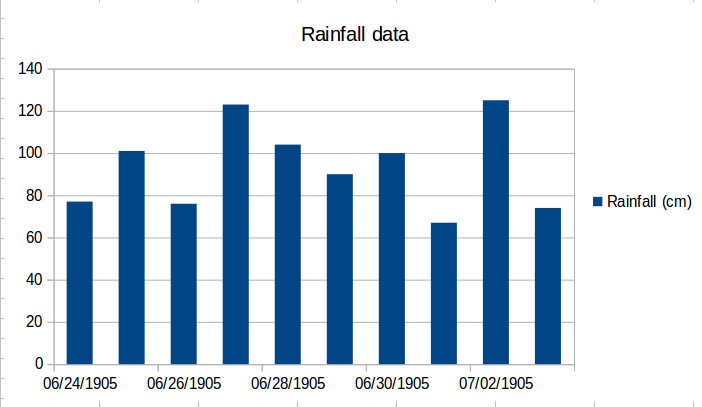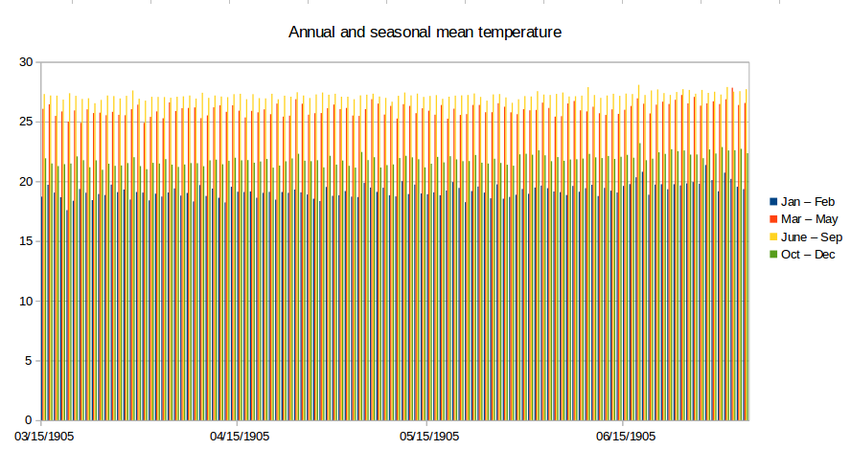Difference between revisions of "ICT student textbook/Spreadsheet for data analysis"
m (1 revision imported) |
m (1 revision imported: from troer) |
||
| (One intermediate revision by one other user not shown) | |||
| Line 10: | Line 10: | ||
===Objectives=== | ===Objectives=== | ||
| − | #Using spreadsheet for data analysis | + | #Using a spreadsheet for data analysis |
#Being able to identify how to group and view data | #Being able to identify how to group and view data | ||
#Analyzing data and representing using charts and graphs; understanding what to analyze in a given data set | #Analyzing data and representing using charts and graphs; understanding what to analyze in a given data set | ||
| Line 21: | Line 21: | ||
#Using spreadsheet for data inputs | #Using spreadsheet for data inputs | ||
#Making charts in spreadsheet | #Making charts in spreadsheet | ||
| − | === | + | ===What resources do you need=== |
| − | # | + | # Working computer lab with [[Explore a computer|projector]] |
| + | # Computers installed with [[Learn Ubuntu|Ubuntu Operating System]] | ||
#Student generated data sets | #Student generated data sets | ||
#Secondary data sets | #Secondary data sets | ||
#Handout for [[Learn LibreOffice Calc|LibreOffice Calc]] | #Handout for [[Learn LibreOffice Calc|LibreOffice Calc]] | ||
#Handout for [[Learn LibreOffice Writer|LibreOffice Writer]] | #Handout for [[Learn LibreOffice Writer|LibreOffice Writer]] | ||
| − | === | + | |
| + | ===What digital skills will you learn=== | ||
#[[Learn LibreOffice Calc|Working with spreadsheets]] | #[[Learn LibreOffice Calc|Working with spreadsheets]] | ||
#[[Learn LibreOffice Calc|Making plots and graphs]] | #[[Learn LibreOffice Calc|Making plots and graphs]] | ||
| Line 44: | Line 46: | ||
'''''Analyzing data from tabulated data - Temperature''''' | '''''Analyzing data from tabulated data - Temperature''''' | ||
| − | Your teacher already discussed the rainfall data with you. You may have wondered about temperature. In the attached file, | + | Your teacher already discussed the rainfall data with you. You may have wondered about temperature. In the attached file (above), along with Telangana rainfall, you also have details of annual and seasonal, maximum and minimum temperature in India. Look at the data and discuss with your teacher what are the various data measures that can be calculated. Your questions may be: |
#What is the maximum temperature by season? Which year was it? | #What is the maximum temperature by season? Which year was it? | ||
#Which year had the highest maximum temperature? Is there any connection between the two? | #Which year had the highest maximum temperature? Is there any connection between the two? | ||
| Line 50: | Line 52: | ||
#What is the difference between maximum and mean temperature? | #What is the difference between maximum and mean temperature? | ||
#Which is the best way to represent this data as a graph? Why? | #Which is the best way to represent this data as a graph? Why? | ||
| − | #What | + | #What additional data sets would you collect? |
#Can you conclude anything from this data set? | #Can you conclude anything from this data set? | ||
| Line 60: | Line 62: | ||
====Student activities==== | ====Student activities==== | ||
Your teacher would have made different data sets for your analysis. Look in your folder on your computer for these data sets. For each of the data sets, identify how you would like to group the data, what to analyze, what measures are important to calculate (average, percentage share, percentage change, minimum, maximum, etc), and also plot the graphs. | Your teacher would have made different data sets for your analysis. Look in your folder on your computer for these data sets. For each of the data sets, identify how you would like to group the data, what to analyze, what measures are important to calculate (average, percentage share, percentage change, minimum, maximum, etc), and also plot the graphs. | ||
| − | # | + | #From time to time, the Indian government conducts census, from time to time, to understand how the population is growing as well as to get some information on how the population is distributed. Would you not like to know about yourself? Check the file [[:File:Simplifed_Census_Data_India_and_Telangana.ods|here]] for the census data. |
#Some data on fruits and flowers and some horticulture products grown in India have been compiled across 10 years. Analyze the data for yourself to see how much more you can learn about flowers and fruits! Click [[:File:Spreadsheet analysis student data file.ods|here]] for the file. | #Some data on fruits and flowers and some horticulture products grown in India have been compiled across 10 years. Analyze the data for yourself to see how much more you can learn about flowers and fruits! Click [[:File:Spreadsheet analysis student data file.ods|here]] for the file. | ||
#You are so familiar with the cellphone. Would you like to see how India's cell phone use compares with the world. Click [[:File:Mobile Connections Spreadsheet Analysis Student data file.ods|here]] for the file. | #You are so familiar with the cellphone. Would you like to see how India's cell phone use compares with the world. Click [[:File:Mobile Connections Spreadsheet Analysis Student data file.ods|here]] for the file. | ||
| − | #Another interesting data is on the number and types of vehicles on the road in India. See what kinds of analysis | + | #Another interesting data is on the number and types of vehicles on the road in India. See what kinds of analysis is possible with this data. Click [[:File:Spreadsheet analysis student data file.ods|here]] for the file. |
| − | |||
| − | |||
| − | |||
| − | |||
| − | |||
===Portfolio=== | ===Portfolio=== | ||
Latest revision as of 09:04, 28 June 2017
Analyzing data with spreadsheets
In this activity, you will have large data sets on different items and you will learn methods of analyzing with spreadsheets.
Objectives
- Using a spreadsheet for data analysis
- Being able to identify how to group and view data
- Analyzing data and representing using charts and graphs; understanding what to analyze in a given data set
- Understanding the meaning of average, percentage difference, percentage share, growth rates, minimum and maximum and other such functionalities.
- Learning the use of different functionalities in spreadsheet for numerical analysis
What prior skills are assumed
- Familiarity with ICT environment
- Understanding of data organization
- Using spreadsheet for data inputs
- Making charts in spreadsheet
What resources do you need
- Working computer lab with projector
- Computers installed with Ubuntu Operating System
- Student generated data sets
- Secondary data sets
- Handout for LibreOffice Calc
- Handout for LibreOffice Writer
What digital skills will you learn
Description of activity with detailed steps
Teacher led activity
Analyzing data from tabulated data - Rainfall
Your teacher will help you analyze the data of rainfall in Telangana, using available data. Click here for the file. Look at the data and discuss with your teacher what are the various data measures that can be calculated. For example, some questions from this data can be the following:
- What is the maximum rainfall amount? Which year?
- What is the minimum rainfall amount? Which year?
- What is the average rainfall in the last ten years?
- Is there any pattern of rainfall?
- Are there other data that you can study along with this data to understand the weather and climate in Telangana? For example, what could be the connection between rainfall data and temperature, crop production or floods?
- Which is the best way to represent this data as a graph? Why?
- What are the additional data sets you would collect?
Analyzing data from tabulated data - Temperature
Your teacher already discussed the rainfall data with you. You may have wondered about temperature. In the attached file (above), along with Telangana rainfall, you also have details of annual and seasonal, maximum and minimum temperature in India. Look at the data and discuss with your teacher what are the various data measures that can be calculated. Your questions may be:
- What is the maximum temperature by season? Which year was it?
- Which year had the highest maximum temperature? Is there any connection between the two?
- By how much does the maximum temperature vary across seasons?
- What is the difference between maximum and mean temperature?
- Which is the best way to represent this data as a graph? Why?
- What additional data sets would you collect?
- Can you conclude anything from this data set?
Student activities
Your teacher would have made different data sets for your analysis. Look in your folder on your computer for these data sets. For each of the data sets, identify how you would like to group the data, what to analyze, what measures are important to calculate (average, percentage share, percentage change, minimum, maximum, etc), and also plot the graphs.
- From time to time, the Indian government conducts census, from time to time, to understand how the population is growing as well as to get some information on how the population is distributed. Would you not like to know about yourself? Check the file here for the census data.
- Some data on fruits and flowers and some horticulture products grown in India have been compiled across 10 years. Analyze the data for yourself to see how much more you can learn about flowers and fruits! Click here for the file.
- You are so familiar with the cellphone. Would you like to see how India's cell phone use compares with the world. Click here for the file.
- Another interesting data is on the number and types of vehicles on the road in India. See what kinds of analysis is possible with this data. Click here for the file.
Portfolio
- In your continuing portfolio, you should create your own spreadsheets with the analysis.
- Your portfolio should also include a text document with a written description of the analysis.
- Your concept map with highlights of your analysis for presentation.


